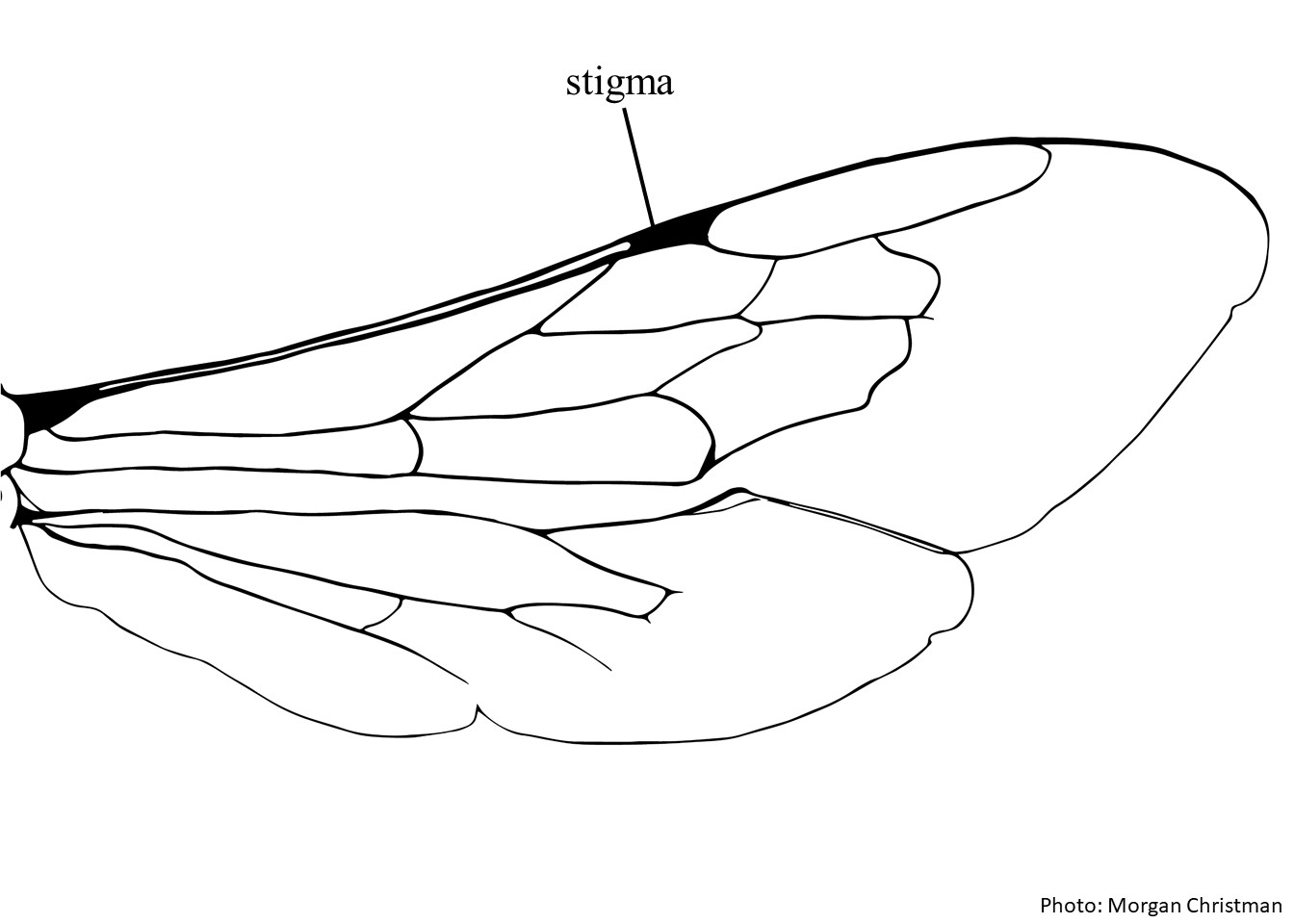Family: Megachilidae
Subfamily: Megachilinae
Tribe: Osmiini
Genus: Ochreriades Mavromoustakis 1956
Subgenera: none
Common name: none
Ochreriades have a distinctly elongated body form and long proboscisproboscis:
an elongated sucking mouthpart that is typically tubular and flexible
that almost reaches the first tergumtergum:
the segments on the top side of the abdomen, often abbreviated when referring to a specific segment to T1, T2, T3, T4, T5, T6, or T7 . They have an overall black coloration with yellow or ivory maculations on their thorax and abdomen, and range in length from 7–10 mm (Michener 2007Michener 2007:
. They have an overall black coloration with yellow or ivory maculations on their thorax and abdomen, and range in length from 7–10 mm (Michener 2007Michener 2007:
Michener, C.D. 2007. The Bees of the World (2nd ed.). Johns Hopkins University Press, Baltimore and London, 953 pp.).
Ochreriades contains 2 species worldwide (Griswold 1994Griswold 1994:
Griswold, T.L. 1994. A review of the Ochreriades . Pan-pacific Entomologist 70: 318ndash;321.; Michener 2007Michener 2007:
Michener, C.D. 2007. The Bees of the World (2nd ed.). Johns Hopkins University Press, Baltimore and London, 953 pp.); none are known to occur in the U.S. or Canada.
(from Michener 2007Michener 2007:
Michener, C.D. 2007. The Bees of the World (2nd ed.). Johns Hopkins University Press, Baltimore and London, 953 pp. unless otherwise stated)
 twice as long as broad or more.
twice as long as broad or more.The presence of distinct yellow or ivory maculations throughout the body of Ochreriades is unique among bees in the Osmiini, and makes this genus difficult to confuse with other bees in this tribe (Michener 2007Michener 2007:
Michener, C.D. 2007. The Bees of the World (2nd ed.). Johns Hopkins University Press, Baltimore and London, 953 pp.).
There are no known invasives.
Ochreriades fasciatus specializes on Lamiaceae and seems to prefer Ballota and Moluccella (Rozen et al. 2015Rozen et al. 2015:
Rozen Jr., J.G., G. Pisanty, V. Trunz, D. Beacute;non, A. Dorchin, and C.J. Praz. 2015. Nesting biology, flower preferences, and larval morphology of the little-known old world bee Ochreriades fasciatus (Apoidea: Megachilidae: Megachilinae). American Museum Novitates 3830: 1ndash;18.). Females gather pollen by tapping their abdominal scopae directly on the flower anthers. Nectar from other plants may be used occasionally. The floral resources used by O. rozeni are unknown, but it is also suspected to be a specialist due to its elongated proboscisproboscis:
an elongated sucking mouthpart that is typically tubular and flexible
(Rozen et al. 2015Rozen et al. 2015:
Rozen Jr., J.G., G. Pisanty, V. Trunz, D. Beacute;non, A. Dorchin, and C.J. Praz. 2015. Nesting biology, flower preferences, and larval morphology of the little-known old world bee Ochreriades fasciatus (Apoidea: Megachilidae: Megachilinae). American Museum Novitates 3830: 1ndash;18.).
Ochreriades fasciatus is solitary but may have aggregated nesting sites (Rozen et al. 2015Rozen et al. 2015:
Rozen Jr., J.G., G. Pisanty, V. Trunz, D. Beacute;non, A. Dorchin, and C.J. Praz. 2015. Nesting biology, flower preferences, and larval morphology of the little-known old world bee Ochreriades fasciatus (Apoidea: Megachilidae: Megachilinae). American Museum Novitates 3830: 1ndash;18.). Nests are made inside preexisting holes made by other insects like wood-boring beetles in dead hardwood trees such as cypress (Cupressus sempervirens) (Rozen et al. 2015Rozen et al. 2015:
Rozen Jr., J.G., G. Pisanty, V. Trunz, D. Beacute;non, A. Dorchin, and C.J. Praz. 2015. Nesting biology, flower preferences, and larval morphology of the little-known old world bee Ochreriades fasciatus (Apoidea: Megachilidae: Megachilinae). American Museum Novitates 3830: 1ndash;18.). Cells are arranged in a linear series and are partitioned by mud probably made with nectar. Larval provisions are laid out in the rear of each cell and are semi-liquid. After females have completed the nest, the entrance is plugged with pebbles and mud (Rozen et al. 2015Rozen et al. 2015:
Rozen Jr., J.G., G. Pisanty, V. Trunz, D. Beacute;non, A. Dorchin, and C.J. Praz. 2015. Nesting biology, flower preferences, and larval morphology of the little-known old world bee Ochreriades fasciatus (Apoidea: Megachilidae: Megachilinae). American Museum Novitates 3830: 1ndash;18.). The nesting behavior of O. rozeni is unknown.
Ochreriades fasciatus is found in the Middle East around Israel, Jordan, and Syria. Ochreriades rozeni is found in Namibia (Michener 2007Michener 2007:
Michener, C.D. 2007. The Bees of the World (2nd ed.). Johns Hopkins University Press, Baltimore and London, 953 pp.).
Distribution map generated by Discover Life -- click on map for details, credits, and terms of use.
Griswold, T.L. 1994. A review of the Ochreriades. Pan-pacific Entomologist 70:318-321.
Michener, C.D. 2007. The Bees of the World (2nd ed.). Johns Hopkins University Press, Baltimore and London, 953 pp.
Rozen Jr., J.G., G. Pisanty, V. Trunz, D. Bénon, A. Dorchin, and C.J. Praz. 2015. Nesting biology, flower preferences, and larval morphology of the little-known old worldOld World:
the part of the world that was known before the discovery of the Americas, comprised of Europe, Asia, and Africa; the Eastern Hemisphere
bee Ochreriades fasciatus (Apoidea: Megachilidae: Megachilinae). American Museum Novitates 3830:1-18.